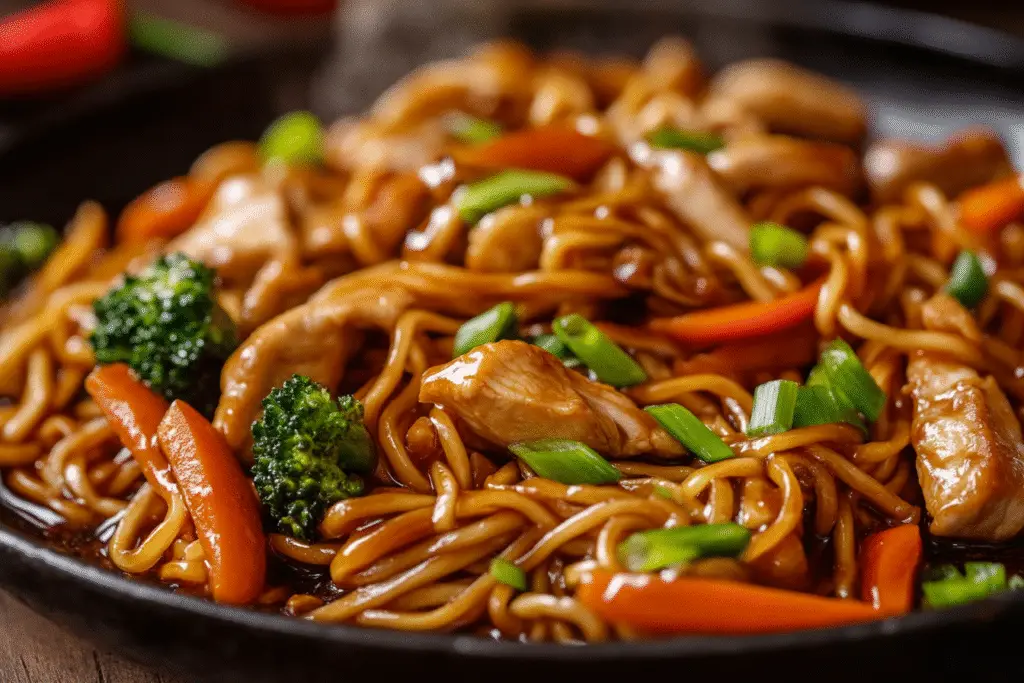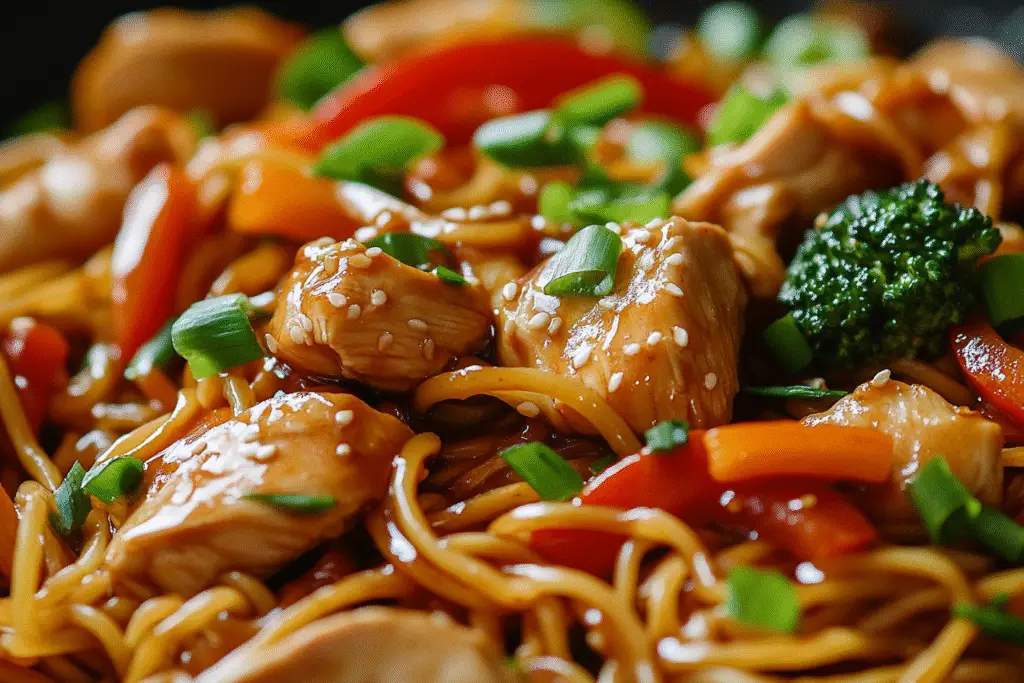Chicken Lo Mein is a beloved Chinese-American stir-fry dish that balances savory, slightly sweet, and umami-rich flavors with tender chicken, crisp vegetables, and perfectly chewy noodles. It’s fast, versatile, and deeply satisfying—a dish that brings the comfort of takeout straight to your home kitchen.
While it might seem complicated at first glance, Chicken Lo Mein is actually an approachable, one-pan meal that comes together in about 30 minutes. The key to success is in preparation: quickly cooking marinated chicken, fresh vegetables, and springy noodles in a flavorful sauce over high heat. With the right tips and a little organization, you can create a restaurant-quality lo mein at home that’s even better than takeout.
This detailed guide will walk you through choosing the right noodles, building a balanced sauce, proper stir-fry technique, common pitfalls to avoid, and plenty of variations to make this dish your own.
Why Chicken Lo Mein Works: Quick Cooking, Rich Flavor, Perfect Texture
The appeal of lo mein lies in its perfect balance of textures and flavors:
- Tender marinated chicken that cooks quickly and stays juicy.
- Springy, chewy noodles that absorb savory sauce without getting soggy.
- Bright, crisp vegetables that add color and crunch.
- A rich, glossy sauce with umami depth from soy sauce, oyster sauce, and sesame oil.
This dish comes together in a flash if everything is prepped ahead—a hallmark of efficient stir-frying.

Selecting the Right Noodles: Chewy and Sauce-Absorbing
Best Noodle Options:
- Fresh lo mein noodles (egg noodles): Ideal for authentic texture.
- Spaghetti or linguine: Good substitute if lo mein noodles aren’t available.
- Ramen noodles: Work in a pinch, especially if fresh.
Cooking Tip:
Cook noodles just until al dente, then rinse quickly under cold water to stop cooking. This prevents them from becoming mushy when stir-fried.
Choosing the Right Chicken: Tender and Quick-Cooking
Best Cut:
- Boneless, skinless chicken breast or thighs: Both work well.
- Thinly sliced for quick cooking and maximum sauce absorption.
Pro Tip:
Marinate the chicken in soy sauce, cornstarch, and sesame oil to tenderize and infuse flavor before stir-frying.

Building a Perfect Lo Mein Sauce
The sauce is the backbone of this dish. It should be savory, slightly sweet, and lightly glossy.
Core Sauce Ingredients:
- Soy sauce: Provides saltiness and umami.
- Oyster sauce: Adds savory depth and slight sweetness.
- Sesame oil: Brings aromatic richness.
- Sugar: Balances saltiness.
- Chicken broth or water: Helps coat the noodles.
Optional Additions:
- Hoisin sauce for extra sweetness.
- Chili paste or Sriracha for heat.
Recommended Equipment
- Wok or large non-stick skillet: Essential for stir-frying.
- Tongs or wooden spoon: For quickly tossing ingredients.
- Large pot: For boiling noodles.
- Mixing bowls: For prepping sauce and marinating chicken.
Common Mistakes and How to Avoid Them
1. Overcrowding the Pan
- Causes steaming instead of stir-frying.
- Solution: Cook in batches if necessary to maintain high heat.
2. Overcooked Noodles
- Can become mushy when stir-fried.
- Solution: Cook noodles until just al dente and rinse quickly.
3. Dry or Bland Chicken
- Happens if chicken isn’t marinated.
- Solution: A quick soy sauce and cornstarch marinade tenderizes and flavors the meat.
4. Lack of Sauce Coating
- Noodles can clump without enough sauce or tossing.
- Solution: Use enough sauce and toss vigorously to coat evenly.
Preparation and Meal Planning Tips
Efficient Workflow:
- Cook noodles and marinate chicken first.
- Chop all vegetables and mix sauce before heating the wok.
Meal Prep:
- Lo mein is excellent for leftovers and holds well for 3–4 days in the fridge.
- Separate the sauce and noodles if prepping for lunches to avoid sogginess.
Flavor Variations and Customizations
Protein Options:
- Shrimp, beef, pork, or tofu can be swapped for chicken.
Vegetable Options:
- Bell peppers, broccoli, snow peas, bok choy, mushrooms, or baby corn.
Spice Adjustments:
- Add chili oil, crushed red pepper flakes, or Sriracha for heat.
- Omit chili for a kid-friendly version.
Gluten-Free Adaptation:
- Use gluten-free tamari instead of soy sauce.
- Substitute rice noodles for lo mein noodles.

Ingredient List
For the Chicken:
- 1 pound (450 g) boneless, skinless chicken breast or thighs, thinly sliced
- 1 tablespoon soy sauce
- 1 teaspoon cornstarch
- 1 teaspoon sesame oil
For the Sauce:
- 3 tablespoons soy sauce
- 2 tablespoons oyster sauce
- 1 tablespoon hoisin sauce (optional for sweetness)
- 1 teaspoon sesame oil
- ½ teaspoon sugar
- ¼ cup (60 ml) chicken broth or water
For the Stir-Fry:
- 12 ounces (340 g) fresh lo mein noodles (or spaghetti)
- 2 tablespoons vegetable oil
- 1 large carrot, julienned
- 1 bell pepper, thinly sliced
- 1 cup broccoli florets (blanched)
- 3 green onions, sliced
- 3 cloves garlic, minced
- Optional: Bean sprouts, mushrooms, snow peas
Step-By-Step Instructions
1. Cook the Noodles
Bring a large pot of salted water to a boil.
Cook noodles until just al dente according to package directions.
Drain and rinse under cold water. Toss lightly with a little sesame oil to prevent sticking.
2. Marinate the Chicken
In a bowl, combine sliced chicken, soy sauce, cornstarch, and sesame oil.
Let sit for at least 10 minutes while prepping vegetables and sauce.
3. Mix the Sauce
In a small bowl, whisk together soy sauce, oyster sauce, hoisin sauce (if using), sesame oil, sugar, and chicken broth.
Set aside.
4. Stir-Fry the Chicken
Heat 1 tablespoon vegetable oil in a large wok or skillet over medium-high heat.
Add marinated chicken and stir-fry for 4–5 minutes until fully cooked. Remove and set aside.
5. Cook the Vegetables
Add remaining 1 tablespoon oil to the wok.
Stir-fry carrots, bell peppers, and broccoli for 2–3 minutes until tender-crisp.
Add garlic and stir-fry for 30 seconds until fragrant.
6. Combine Noodles and Sauce
Return chicken to the wok.
Add cooked noodles and pour sauce over everything.
Toss vigorously to coat the noodles and chicken evenly in the sauce.
Stir-fry for another 2–3 minutes until heated through and sauce is glossy.
7. Serve
Garnish with sliced green onions and additional sesame oil or chili oil if desired.
Serve hot and enjoy immediately.
Troubleshooting and FAQs
Can I use spaghetti instead of lo mein noodles?
Yes. Spaghetti is a great substitute and holds up well to stir-frying.
How do I prevent the noodles from clumping?
Rinse noodles under cold water after cooking and toss with a little sesame oil.
How can I make this vegetarian?
Use tofu instead of chicken and replace oyster sauce with a vegetarian stir-fry sauce.
Can I make lo mein ahead of time?
Yes, it reheats well. Store in an airtight container in the fridge for up to 4 days.
Variations: Classic, Spicy, and Vegetarian Versions
| Version | Protein | Sauce Notes | Vegetables |
|---|---|---|---|
| Classic | Chicken breast or thighs | Traditional lo mein sauce | Carrots, bell peppers, broccoli |
| Spicy | Chicken or shrimp | Add chili oil or Sriracha | Add mushrooms or snow peas |
| Vegetarian | Tofu or none | Use vegetarian stir-fry sauce | Bok choy, mushrooms, bean sprouts |
Storage and Reheating Tips
- Storage: Keep leftovers in an airtight container in the refrigerator for up to 4 days.
- Reheating: Stir-fry quickly in a hot pan or microwave with a splash of water to loosen the noodles.
- Freezing: Not recommended as noodles may become mushy upon thawing.
Final Thoughts
Chicken Lo Mein is one of those quick, satisfying dishes that feels like a treat but is easy enough to make on a busy weeknight. With chewy noodles, savory sauce, crisp-tender veggies, and juicy chicken, it’s a guaranteed crowd-pleaser that can be adapted to fit any taste or dietary preference.
Whether you spice it up, pack it with extra veggies, or try it with shrimp or beef, this versatile dish is a great foundation for endless flavor combinations. I hope this step-by-step guide helps you make the perfect Chicken Lo Mein at home—feel free to experiment and make it your own!
